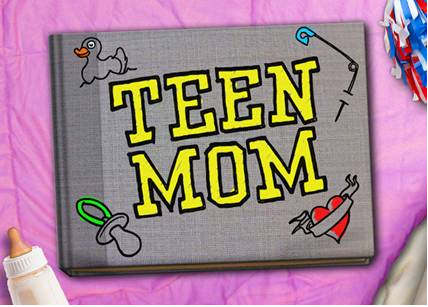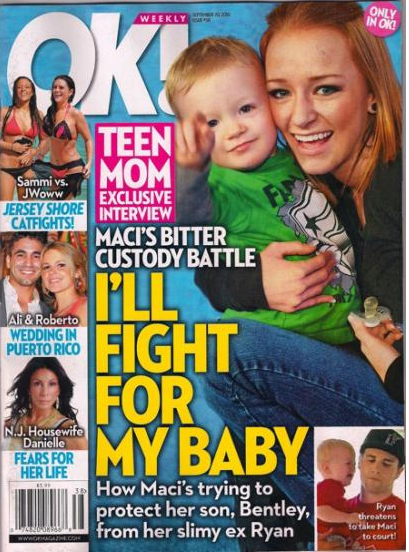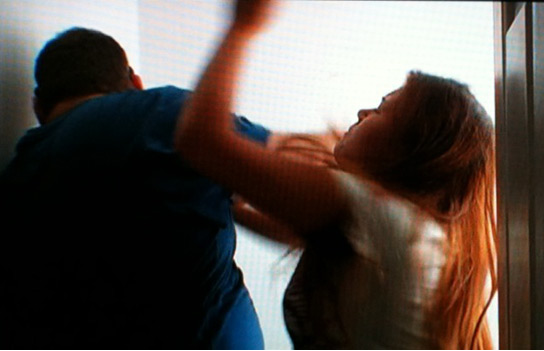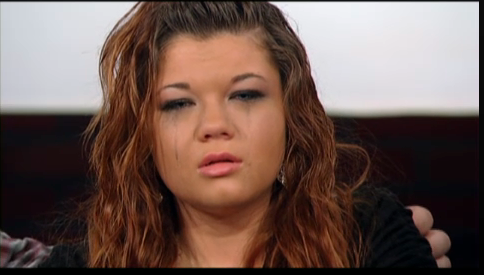Welfare Queen Redux: Teen Mom, Class and the Bad Mother
Amanda Ann Klein / East Carolina University

In the 1980s the archetypal Bad Mother, the so-called “welfare queen,” was deployed by the Reagan administration to signify the failure of the liberal agenda of the 1970s. According to the Reagan narrative, these so-called welfare queens were using their welfare checks to purchase Cadillacs and jewelry, rather than food and clothing for their children. Explicitly, this image of the Bad Mother signified that the welfare system was ineffective and needed to be dismantled. Implicitly, however, this image suggested that poor, African American women were incapable of properly caring for their children, even when the government provided them with the money to do so. MTV’s reality series about the aftermath of unplanned pregnancies, Teen Mom, relies on a similar trope of class-based villainy. Amber, a working class, Caucasian woman who beats her boyfriend and screams at her child, operates as the series’ archetypal Bad Mother. The series’ exploitative reunion special does acknowledge that Amber’s history of domestic abuse and her inability to complete her high school degree has impacted her ability to effectively parent her child. However, within the diegesis of Teen Mom, Amber’s status as Bad Mother is used to generate viewer outrage and drive home the series’ message about the dire consequences of teen sex, particularly for the financially destitute.
After airing a series of successful reality programs focusing on the lives of wealthy, privileged teenagers, such as Laguna Beach and The Hills, MTV took a decidedly different approach with Teen Mom. Tony Di Santo, MTV’s President of Programming and Development, explains that the show was created in order to cater to the desires of its target audience of Millennials: “This generation wants their reality more ‘real’ which led us to hits like Sixteen and Pregnant, Jersey Shore, and Teen Mom.” In addition to its ratings success— the program is consistently number one in its time slot with the coveted 12-34 demographic — Teen Mom has also been a popular culture fixture since this summer’s season 2 debut. Its young cast has been featured on the covers of numerous magazines and concerns over the show’s alleged “glamorization” of teen pregnancy have been debated on blogs, in online magazines and in major news sources. In other words, the show’s images are highly visible, culturally resonant, and therefore, worthy of critical investigation.

The extradiegetic spectacles surrounding Teen Mom do appear to glamorize teen pregnancy. But within its diegesis as well as its paratexts, Teen Mom strives to promote and encourage responsible teenage sexual behavior. Public Service Announcements about teen pregnancy air during commercial breaks and MTV’s Teen Mom companion website hosts links to sites like StayTeen.org, which promotes teen abstinence, and It’sYourSexLife.com, which promotes safe sex. The show itself conveys this message by showing how difficult parenting can be. Though these aims are laudable, it is significant that Teen Mom’s primary warning image is Amber. She is estranged from her family and therefore receives no financial or emotional support from them. She has a physically and emotionally abusive relationship with the father of her child, Gary; the couple frequently engages in loud, violent arguments in front of their daughter. Although the series avoids overt didacticism within the diegesis, the editing and cinematography still invite us to evaluate and judge each mother’s actions. Indeed, Amber’s status as Bad Mother is further bolstered by frequent cutaways that highlight the semantics of poor parenting; close-ups of piles of clothing heaped in corners, cardboard moving boxes that are never unpacked, Leah’s bare crib mattress, and shots of Leah playing alone with potentially dangerous household items or near open windows, are all damning statements on Amber’s inability to parent her child.
We are also asked to judge Amber’s behavior when it is juxtaposed with that of the series’ other, more responsible mothers. These women certainly have their struggles: Maci grapples with a bitter custody battle and Farrah must come to terms with the death of her daughter’s father. However, both young women have their high school degrees, as well as support and financial help from their middle class parents. Catelynn, the fourth woman profiled on the program, serves as a particularly damning counterpoint to Amber. She and her fiancé, Tyler, were reared in broken and abusive homes and consequently decide to give their daughter, Carly, up for adoption to a stable, middle class couple. However, Catelynn’s mother, April, who is a verbally abusive alcoholic, views the couple’s decision as a personal attack (she was a teen mom herself). April routinely calls Catelynn a “bitch” and refuses to comfort her as she mourns Carly’s absence. In these moments April becomes yet another spectacle of the Bad Mother, further reinforcing the show’s message that the only way that the poor and the abused can be Good Mothers is by giving their children away to someone else. This perspective on class and motherhood is supported by the show’s paratexts, such as the following Public Service Announcement, starring “celebrity teen mom” Bristol Palin. This ad, which aired during the commercial breaks of several episodes of Teen Mom, implies that teen motherhood is only untenable for those from the social underclass.
[youtube]http://www.youtube.com/watch?v=YpHlztPeHf8[/youtube]
The only time when MTV complicates this black and white message is during the exploitative Teen Mom reunion special, hosted by the ubiquitous Dr. Drew Pinsky. During the reunion show, Amber, like all of the teen moms, must rewatch key scenes from the season and then discuss them with Dr. Drew. Not surprisingly, Amber’s highlight reel is a montage of Bad Motherhood. When Dr. Drew replays the series’ most controversial scene, in which Amber repeatedly punches and kicks Gary, a screen within the screen displays Amber’s real time reaction to the images; she grips her head with both hands, rocks back and forth, and sobs. It is clear that Amber is ashamed of her behavior and sees it as wrong. During this segment we also discover that Amber and Gary were both reared in abusive homes. For the first time, Amber’s image as Bad Mother is contextualized, demonstrating how victims of domestic violence often grow up to perpetuate the violence they experienced or witnessed as children.

After discussing this violent episode with Amber and Gary, Dr. Drew tells the studio audience that “80-90% of kids living in homes with domestic violence are fully aware of what is going on” and offers help numbers for male victims of domestic violence. Here, Amber’s life and its misfortunes are converted into a Public Service Announcement. MTV has a responsibility to make such announcements, but presenting Amber as the case study for what not to be further demonizes and dehumanizes this very troubled woman (particularly since she is present as Dr. Drew describes how awful her behavior is). It is also significant that Amber is the only mother who is asked the question: “How would things be different if you didn’t have a baby?” Later, Dr. Drew asks her to imagine the advice she would give to her daughter at age 16. Amber tearfully urges: “Don’t have sex. Don’t even go near it.”

At the conclusion of Amber’s interview, a smug Dr. Drew pats her arm and says: “Makes you want to change, doesn’t it?” Certainly Amber should want to change: punching her lovers and screaming at her child are damaging behaviors. But like Reagan’s villainous welfare queen, Teen Mom’s image of the Bad Mother obscures the very real socioeconomic issues that have created her: Amber lacks a family support system, is unable to complete her education, and was raised in a home filled with physical and mental abuse. Instead of investigating these important issues—how the cycle of abuse perpetuates more abuse—Teen Mom deploys the image of the Bad Mother as a straw man embodying the dangers of unprotected sex. Teenagers are asked to gaze at Amber’s life in horror and, consequently, remain virgins for as long as possible.
Image Credits:
1. MTV’s Teen Mom
2. OK! magazine cover
3. Amber beats Gary
4. Teen Mom reunion special
Please feel free to comment.
Pingback: Welfare Queen Redux: TEEN MOM, Class and the Bad Mother « judgmental observer
Thanks for this column, Amanda. I want to incorporate Teen Mom in my Reality TV syllabus for next semester, and this column will serve as a great reading.
Amanda,
I forgot to include my actual comment!
I’m really glad you wrote about the class-based assumptions of a bad life in Teen Mom. I find it interesting that, in the midst of a horrible recession, reality TV often is saying, “Look at how much these poor people suck.” I’m working on some similar issues with class, race, and Flavor of Love. I think tabloid TV is changing and no longer giving a voice to those with little social power.
Thanks again for the thoughtful post.
Thanks for your comments! Your class sounds great!
I think that you’re right about reality TV–there is a lot of hidden class and racial prejudice going on in these programs. A few years ago I was on a conference panel with Kristin Warner, who gave a great talk about race and FLAVOR OF LOVE. You might also find that paper useful for your class. Let me know if you want me to forward you her contact information.
Yes. Thanks! You can email me at kraszejo@shu.edu.
This article reminds me of a few articles I read about the novel Push and the movie Precious. While Amber serves as a reminder as the how the cycle of abuse can continue, Precious Jones shows there is another way to raise a child if you have come from an abusive home. And while Precious’ story is fictional it does give hope to those people who come from verbally and physically abusive homes. It shows these people that the cycle of abuse can end but it has to end with them. I think that if Amber gets help she will be able to learn to control her temper, just as Precious did, and she will be able to raise her child in a more stable home.
One thing I do not agree with is the criticism of Amber’s home having heaps of clothes or unpacked boxes. It seems that we as a society often forget to look at ourselves for these behaviors as well. The physical and verbal abuse can be seen as signs of bad parenting, but the clothes and the boxes show that she is a single mother with a lot of things she needs to do and clothes on the floor and boxes are not her priority right now.
Also, it seems that abuse or domestic violence is only portrayed in “lower-class” environments or families, when in fact domestic violence occurs in over 22% of middle-class homes as found on the “Abuse, Rape, and Domestic Violence” resource page. I know that not everything can be covered in one article or television show but I think it is healthy to recognize domestic violence in other arenas besides lower-class environments.
It is shameful that we as a society do not support these women more carefully. Also to vilify these women for getting pregnant is ridiculous. It is like looking at the anthill we as a society set on fire. Without societal support do we even wonder what will happen? The Bad Mother is just a stereotype that is continued whenever popular culture deems it necessary to teach us mere humans a lesson about motherhood and sex. The welfare system has failed these youths.
It also seems that abuse is only by poor people in the media. Which is incorrect, and sad. Abuse knows no boundaries or demographics. To say that only welfare mothers abuse or they perpetrate the most abuse is a sad statement of our society.
Thanks for the wonderful article.
I have to agree with Matt B. on this. The women portrayed in these shows may serve as warnings to other teens, but they certainly cannot be vilified for getting pregnant. Instead, they should receiving support from society that they aren’t receiving from their own families. The unfortunate situation of teen pregnancy isn’t something to sit back and shake our heads at. We, as a society, need to do more than just use them as an example. We need to help so that the cycle doesn’t repeat itself.
And, as the article and Matt B. have stated, the women shown in these shows come from abusive, lower-class homes and are often supported by welfare. In reality, abuse happens in every family type and every class level. The same goes for pregnancy. The most important thing that we can do is keep teens educated and let them know their options. They should know how to practice safe sex or abstinence. And they should know who they can turn to when they experience abuse.
Thanks for your comments Kathleen, Matt and Allison.
Kathleen, I want to make it clear that *I* am not critical of the piles of clothing and the general messiness of Amber’s apartment. By pointing out those details of the mise en scene I was arguing that MTV’s cameras show the viewer these details as a way to demonstrate to us that Amber is not able to stay on top of her household chores. Her apartment is far messier than Maci’s or Farrah’s apartment and I believe that the show wants us to see that difference as a way to further judge and demonize Amber. As in the domestic melodrama, a cluttered, disorganized mise en scene is reflective of the inner state of the show’s characters.
And as you point out domestic violence is a problem affecting individuals from all socioeconomic classes. However, the topic of this short article was TEEN MOM’s Amber and how the series villifies this woman without acknowledging (at least until the reunion special) that she was also a victim of domestic violence. I was not arguing that domestic violence is a problem only faced by those with less money and resources.
Thanks for this interesting analysis Amanda. Coming from a girls’ studies perspective, I am wondering how the fact that the show focuses on girls (rather than adult women, boys, etc) impacts the way the show has been received amongst viewers as well as the mainstream media?
It seems as though the show is very much invested in these girls as quintessential “at risk” girls (Anita Harris outlines this well in Future Girl), enforcing many of the neoliberal ideologies at play with the “at risk girl.” However, it also seems as though a select few are pushed towards becoming “can-do” girls, as evidenced by the “empowering” magazine cover you show. I am curious about the ways these images/discourses are juxtaposed against one another (as you discuss in relation to Amber) and what they’re saying about girls specifically. Thanks again! :)
Thanks for your thoughtful comments, Jessalyn. I am not familiar with Harris’ book but now I plan to go out and get it!
Without having read it, I can’t reply in any detail to your question, though given what you’ve described I would say that yes, some of the girls on the show are positioned as “can-do girls” (specifically Maci) while Amber is clearly “at risk.” These distinctions boil down to class and education for the most part. By contrast, on SIXTEEN AND PREGNANT most of the girls (at least in the episodes that I’ve seen), are portrayed as at risk: they’re relationships with their baby daddy’s are rocky, they struggle to complete their HS degrees, they often have to live at home, etc. These girls are in trouble because they are girls–too young, too uneducated, too immature. I doubt THIRTY AND PREGNANT would garner much of a viewership!
Pingback: My Popular Culture New Year’s Resolutions « judgmental observer
Teen Mom: A Warning or Glamorization of the Reality Star?
This article brings up some very relevant issues about the MTV reality show, Teen Mom, such as the show’s attempt to promote safe sex, for example ”…Teen Mom strives to promote and encourage responsible teenage sexual behavior. Public Service Announcements about teen pregnancy air during commercial breaks and MTV’s Teen Mom companion website hosts links to sites like StayTeen.org, which promotes teen abstinence, and It’sYourSexLife.com, which promotes safe sex.” These websites appear with the warning above them, “Teenage Pregnancy is 100% preventable,” to prevent teenage pregnancy from affecting its viewers. Although this may seem as the network’s motive, the show itself, the rising popularity, and continued airing, in my opinion, places celebrity status on the four girls of the show. It is a danger to air programming that rewards these girls, who are receiving a paycheck at the end of the day, and turning these Teen Moms into celebrities.
If you look closely at Amber, Maci, Catelynn, and Farah, their lives have been completely transformed because of the television show. These girl are everywhere, from reunion specials to magazine covers. They have truly turned their choice to have a child into the best situation. Sure, all four of these girls have their bad moments on the shows, including the domestic abuse situation with Amber and her former boyfriend Gary, but in the end, the girls seem to become better looking, and their lives much improved every time we see them, including Amber’s amazing 60 lb. weight loss. Without their teenage pregnancy, none of these girls would have ever become a celebrity and sadly, for the rest of the population, having a child at such a young age does not make life easier. Cash flow is never enough, lives are significant harder, and the rest of country’s teen moms never become celebrities.
If MTV really wants to show a well rounded version of different sexual options, as they claim to be doing with their warning signs and promotion of websites (which places the responsibility of the viewer to even go to these websites at all), the show should follow virgins, girls who have decided to not have sex, as well as girls who practice safe sex, and even those who have decided to have abortions when they found themselves in the less than desirable situation of an unplanned pregnancy. At least then, audiences would have different lives and choices to compare, and they could make up their own minds about who made the right decision in the end. By focusing on one choice—to have a child and raise it on your own, MTV is inadvertently steering girls towards this direction. Even placing the PSA of Bristol Palin, the ultimate celebrity teen mom, in this article screams, “Hey girls! You could become a celebrity too with your pregnancy!”
Hi Nicole
I agree that TEEN MOM does, despite MTV’s efforts to the contrary, glamorize teen pregnancy. MTV did air a 1-hour TRUE LIFE episode devoted to celibacy. But imagine that an entire season about celibacy or safe sex would not garner ratings (indeed, this is the network that is currently airing SKINS).
Another way to show the hardships of teen pregnancy would be to include a wider range of classes, races and ethnicities. I still find it very shocking that neither TEEN MOM or TEEN MOM 2 features a non-white women. And none of the women depicted are completely financially destitute–Amber at least had Gary’s mother to lean on and Kailyn (of season 2) has been able to live with Joe’s family (at least for a while). To really discourage teen pregnancy I would love for MTV to show us a teen mother who is utterly alone (as so many are in real life), living on food stamps, and wondering if she will have a roof over her child’s head tomorrow.
Pingback: “THE HILLS, JERSEY SHORE, and the Aesthetics of Class” « judgmental observer
Pingback: Supplementary Screening: Teen Mom as Cautionary Tale « Introduction to Television Studies